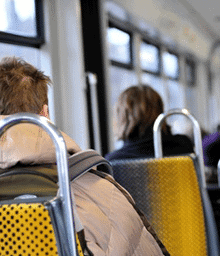Make the Most of Public Transportation
 Did you know that most Carrington College campuses have excellent connections to public transportation systems?
Did you know that most Carrington College campuses have excellent connections to public transportation systems?
Many of our campuses have convenient locations with bus stops right next to the campus, or at least a short walk away. Students at our Portland, OR, campus are very lucky; the campus is within TriMet’s Free Rail Zone, so they can get to campus free on the MAX Light Rail system. What’s more, did you know that Portland was ranked as the nation’s best city for public transportation in 2011 by US News magazine?
Most students operate on a tight budget; did you know that enrolled students can get discounts on most public transport systems? Speak to your campus front desk for local information, or inquire with the city or county about any student travel discounts you may be entitled to.
As gas prices go up, think about the money you could save? Statistics show that households that use public transportation and can live with one less car can save on average $9,000 every year*! As we all look for ways to save money, that’s something to seriously think about.
Public transportation, except for ferries, was not a common part of life until the 19th century, as home, work, school, and recreation were almost always within walking distance. As distances increased, horse-drawn carriages were introduced to meet the need for better mass transportation.
In 1827, a transit service was first provided in lower Manhattan in New York City, using horse-drawn carriages. In 1831 a vehicle designed especially for transit service, the horse-drawn Omnibus (a bus for all), was introduced copying an idea that had recently been introduced in Paris and London. For 12cents, about $3.30 in today’s money, a passenger could ride 2 miles from the Battery north to Bond Street.
It wasn’t until the 1910-1920 period that improved street paving and the increasing affordability of the internal combustion engine led to the widespread introduction of buses. Here are some facts you might find interesting, courtesy of APTA, the American Public Transportation Association.*
Quick Facts
- In 2011, we took 10.4 billion trips on public transport, the 2nd highest annual ridership since 1957.
- People board public transportation 35 million times each weekday.
- From 1995 to 2011 public transportation ridership increased by 34% – a growth rate higher than the 17% increase in US population and higher than the 22% growth in the use of our highways.
- Public transportation is a $56 billion industry that employs nearly 400,000 people.
- More than 7,200 organizations provide public transportation in the United States.
Public Transportation Saves Money
- The average household spends 16 cents of every dollar on transportation, and 94% of this goes to buying, maintaining, and operating cars, the largest expenditure after housing.
- Households likely to use public transportation on a given day save more than $10,000 every year.
Public Transportation Reduces Gasoline Consumption
- Public transportation’s overall effects save the US 4.2 billion gallons of gasoline annually.
- Households near public transit drive an average of 4,400 fewer miles than households with no access to public transit. This equates to an individual household reduction of 223 gallons per year, or about $750-$850 a year depending on your local gas prices.